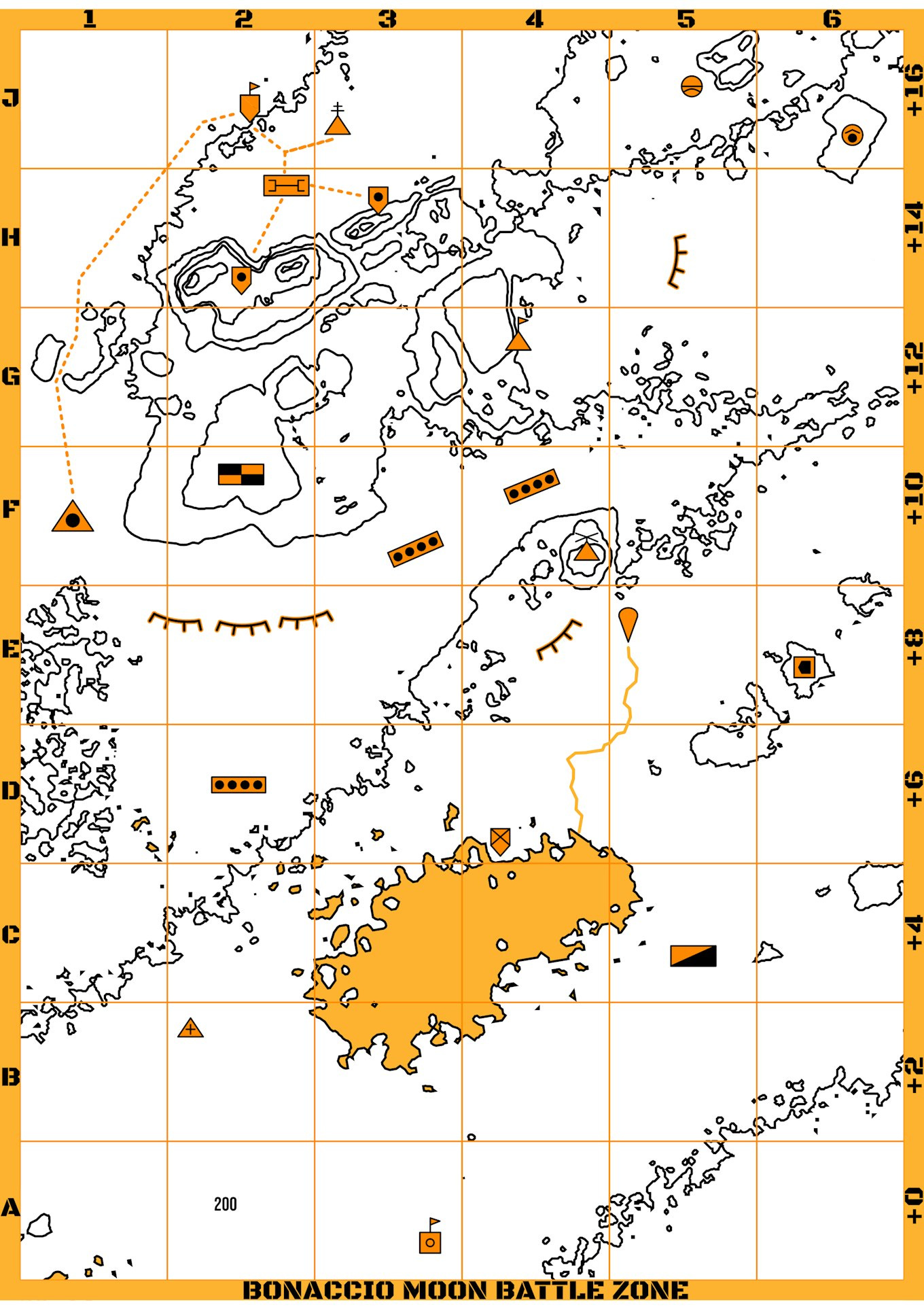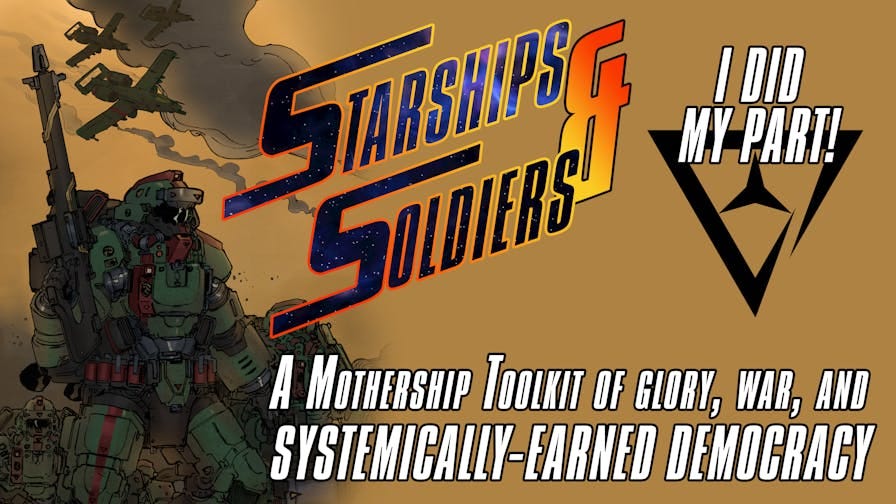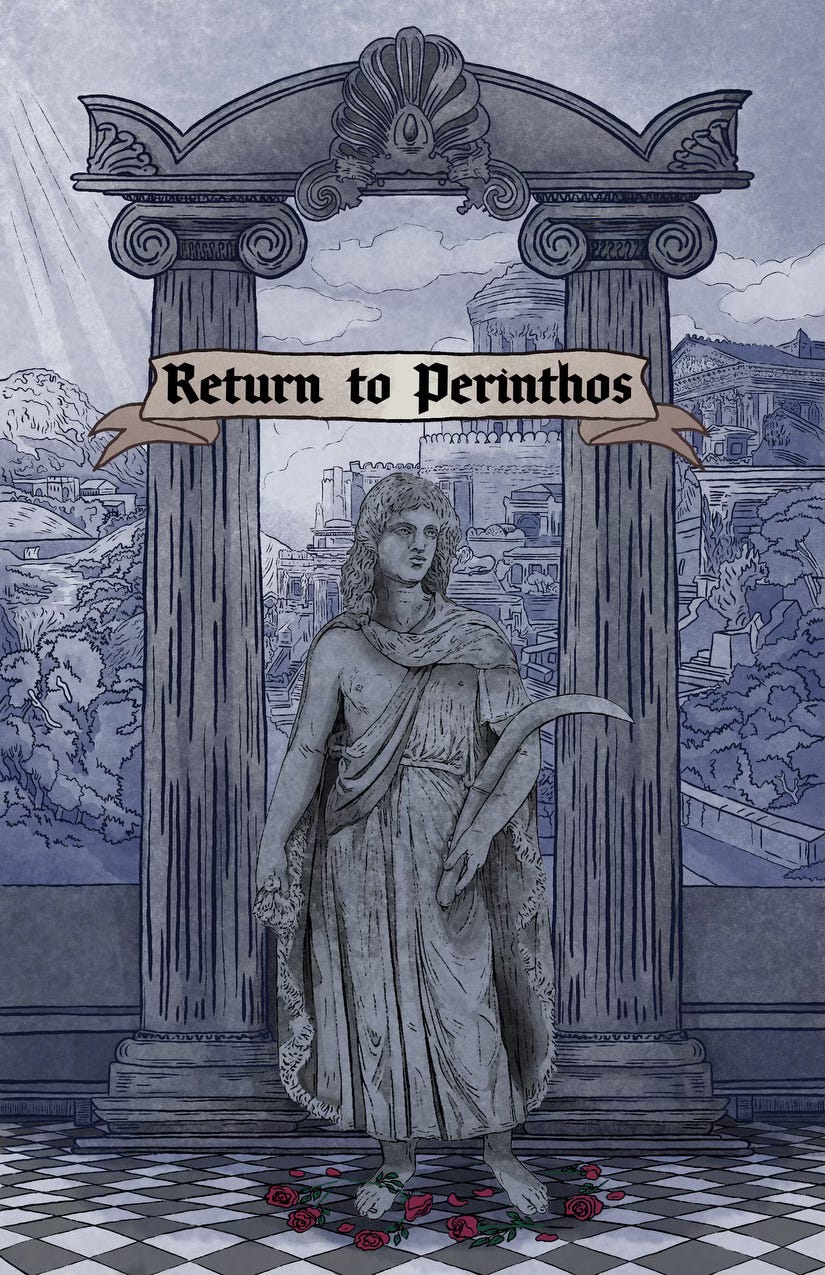The Adventure Gaming Periodical - Issue #16 - Solo-First Investigation System Design
The Development of a Solo-First Investigation System and Mothership Month Announcements
Welcome to the newest edition of The AGP!
In this issue I am going to trace the development of the investigation system for my upcoming campaign adventure module for Mothership 1e that is launching as part of Mothership Month 2024: Orgy of the Blood Leeches. I will also have some brief coverage of the five (😅) other projects that we are distributing for Mothership Month, in addition to our other crowdfunding projects that we are currently closing out. This is a long issue, so if you’re reading via email instead of the Substack app, you may need to click to continue to read everything in your email client.
What is Orgy of the Blood Leeches?
“A twisted descent into a sex-soaked, blood-filled, Queer horor story by one of Mothership’s leading auteurs.”
watt, Creator of Cloud Empress
At its heart, Orgy of the Blood Leeches, is an investigation adventure; however, the scenario is much less an investigation procedural and much more Twin Peaks.
The set up is a murder mystery stacked on top of a political powder keg.
Parasitic Leeches have overrun Trellick Station, a luxury living space station built for white collar workers.
A young adult trans sex worker, Brianna Pilgrim, was murdered and a mysterious doctor running a practice in organ replacing leeches disappeared.
The system is on the verge of a war. Reactionary evangelists, radical feminist separatists, and corporate fascists are squaring up against the Interstellar Sex Workers Union.
Are you able to solve the murder in time? Can you find justice for Brianna before her death is used as a pawn in the political game?
However, it’s not just a straightforward murder mystery. In gameplay, it strives to be much closer to an immersive sim than any other genre. Ordinarily, immersive sims only provide simulations of environments and the locations of NPCs and other systems, but this adventure also wants to apply this to social situations. Much like how Ursula K. LeGuinn referred to her work as a social science fiction, Orgy of the Blood Leeches is a social immersive simulation. I view this as being different from your typical ttrpg or crpg sandbox since there is still a singular mission to accomplish, so it is a limited sandbox. Another key component of this sandbox is that I design everything to be playable either solo or Wardenless from the ground up.
As part of developing this mystery I had to develop the cast of ten murder suspects who include:
Brianna Pilgrim (she/they) - Murder Victim
Sheriff Woodrow Wilson (he/they) - Sheriff of Trellick Station
Dr. Johannes Lethian (he/him) - The Creator of the Blood Leeches
Nick Henry (he/him) - Brianna’s Regular Client and Second Murder Victim
Addie Flynn (they/them) - Representative for the Interstellar Sex Workers’ Union
Dr. Rogelio Luca (he/him) - The Medical Officer Onboard Trellick Station
Amanda Davis (she/her) - Corporate Administrator for Trellick Station
Pamela Posier (she/her) - Activist for the Radical Feminist Liberation Front
Benjamin Dryden (he/him) - Fascist Corporate Spy
Victoria Valentine (they/them) - Brianna’s On-Again/Off-Again Partner
Investigation System Attempt #1 - Static Murderer, Static Clues, Gumshoe Inspired
I had a scenario and a set of suspects, and I decided to play out in my head who I thought the murderer could be from the most obvious to the most obtuse. I did research into traditionally designed investigation design, at this point in time I read Gumshoe and the guidelines for designing mysteries that were published in Hull Breach. I appreciated how these eliminate the roll for clues aspects of static mysteries as approached in other systems, but there is still a clear critical path even if you place multiple clues lots of places. It really didn’t accomplish my goal of building a social immersive sim that can be playable solo or Wardenless.
This is when I came back to Twin Peaks. David Lynch and Mark Frost have said that they never wanted to reveal the killer in Twin Peaks because then it turns it into a run-of-the-mill secret, it’s revealed, and it’s done. The mystery doesn’t keep going, and the real charm of Twin Peaks is the town and the characters, Laura Palmer’s murder is just a way to get you there. I actually believe that they did not even know who the killer was until Bob Iger (yes, that Bob Iger) forced them to do the reveal. Twin Peaks is a descent into weirdness, not a procedural whodunit, and having a static murderer with static clues doesn’t support this kind of vibe.
At the same time I was grappling with this, I hung out at a party with a bunch of lawyers, and I realized that it doesn’t matter if an investigator knows who committed a crime, without a solid case file and evidence, no prosecutor is going to touch the case to bring it in front of a judge. That brought me to my next attempt at an investigation system.
Investigation System Attempt #2 - Chosen Murderer, Procedural Clues
My next version involved the Warden either rolling for or choosing one of the ten suspects at the start of the adventure. The clues are then picked up procedurally as the players explore Isolation Zones that have been blocked off from the rest of Trellick Station due to leech infestation. Players would need to get three clues from every single Isolation Zone, they would need to speak with all living suspects, and examine both victims dead bodies before they could pitch their case file to the Warden who would tell them if they were correct or if they need to fix something in their case file. The case file is a simple tracker for players where they can place clues into three columns: “Means, Motive, and Methods.” This is influenced by Sean McCoy’s Investigation Sheet.
The rolled for murderer and procedural clues gave things more of an immersive sim vibe that in my first attempt, but it still left too much up to Warden fiat when trying to develop a simulation. This also makes solo or Wardenless play involve more creation of material than I prefer, my design style for solo and Wardenless play tries to minimize the use of oracles and journaling through the use of procedures.
Investigation System Attempt #3 - Doing the Columbo, Revealed Murderer, Procedural Clues
For my next attempt, I came back to Twin Peaks. When I first experienced Twin Peaks it was for a college class on the works of David Lynch, and my professor decided to introduce us to the show in chronological order, so my first introduction to Twin Peaks was Fire Walk With Me. I then watched the entire show already knowing who the killer was. I didn’t experience the show as a whodunnit but as a how/whydunnit, and I feel as though this actually accomplished the goals that David Lynch and Mark Frost set out with Twin Peaks. I was focused on the characters and their relationships and the mysteries of the Red Room, the Black Lodge, and the White Lodge more than I was trying to solve “Who killed Laura Palmer?”
It was at this same time that serendipitously, I started watching Poker Face, and then Columbo. Both of these shows start by showing you the murder, and the main characters are very intuitive, so they also immediately know, so their task is about finding the evidence to build a case, and this is the vibe that I wanted for my investigation system.
This led to rolling for the murderer out of the suspects and then revealing the killer to the players at the start of the adventure. It’s about weaving together the random clues into a case file and narrative that give context and allow you to seek justice for Brianna. However, the decision for whether the case file is correct or incorrect was still determined by Warden fiat, and that is an issue when designing towards solo or Wardenless play that is more about player emulation than GM emulation.
Investigation System Attempt #4 - Revealed Murderer, Procedural Clues, In-Fiction Confirmation Procedure
As my brain stewed on a way to confirm a case file procedurally, I came back to Brindlewood Bay even though I had scoffed at case solving procedure like the Theorize move in that game. However, an in-fiction solution to this came to me, I realized that the module needed to have “The Twist” about 75% of the way through the adventure. I needed to come back to the Asian story structure of Kishōtenketsu, the four act story structure (and to remind myself of The Tilt Table in Fiasco!)
Introduction (ki): an introduction to the characters, era, and other information required to understand the plot.
Development (shō): follows leads towards the twist in the story. No major changes so far.
Twist (ten): the story turns toward an unexpected development. This is the crux of the story, the yama (ヤマ) or climax. If the narrative takes several turns, this is the biggest one.
Conclusion (ketsu), also called ochi (落ち) or ending, wraps up the story.
Adding The Twist to go the game adds an in-fiction reason for why the party would know who the murderer would be ahead of time and established major moral decision for players to make. Part of this moral decision is whether they interact with a system that can procedurally tell them with utmost certainty whether their case file is correct or not, cribbing from the system in Brindlewood Bay. They can choose not to interact with this system based on their decision, but that may lead to a false conviction or a case file with errors that allows the murderer to not be prosecuted or convicted.
Working with my editor, we realized that this confirmation system also needed some guidance for failure. At first we just used a d10 table split into “Means, Motive, and Methods” without more detail than that. My editor then suggested adding more detail to this table since the simple error table still leaves a lot to Warden fiat, still making it difficult to play solo or Wardenless without extensive use of an oracle or a journaling style approach.
Investigation System Attempt #5 - Player-Driven Murderer, Procedural Clues, In-Fiction Confirmation Procedure
The final piece in developing an investigation system that can provide support Wardened, solo, or Wardenless play was developed after quite a bit of back and forth with my editor. Giving players the murderer could diminish the buy-in to the module or give away The Twist early because players have their own ideas. They could also not trust the culprit given to them, so I finally relented and moved to a player-driven system. Players choose who they think the murderer is with no predetermined outcome, they collect the clues procedurally to build their case file, and then they choose whether or not to interact with the in-fiction case file confirmation procedure based on their decision resulting from The Twist. A solo player or a Wardenless player are able to interact with these systems without using an oracle or free form journaling (unless they’d like too), and it creates a simulation that runs independently of Warden fiat, giving the social immersive sim flavor for parties of all types. It took five revisions, discussions with a close colleague, and four rounds of developmental editing with two different editors to get the system to where it is now. I have included the procedure below, stripped of the in-fiction information that would reveal The Twist.
To check their case file against the memories of the suspects, players make an Intellect Check @ [+], including an applicable skill. Use the highest Intellect in the party and the most useful skill from the party.
Players gain 1 percentile bonus for each Clue collected and used in the party’s explanation.
Players gain 3 percentile bonus for each living suspect who they interview.
Players gain 3 percentile bonus for each dead suspect’s body they examine.
Remember that no matter how high these bonuses raise the target for the check, a roll of 90-99 is always considered a failure.
On Success, their Case File is correct and ready to prosecute.
On a Critical Success, players receive Investigation, a Master Tier Skill.
On Failure, their Case File is incorrect. Use the following Case File Error table to determine what portion of the Case File is wrong.
On a Critical Failure, the party has chosen the wrong suspect. Roll 2d10 to choose two different suspects. The real murderer is one of those two suspects, and players must choose one and alter their case file accordingly. If players roll a Critical Failure a second time, do not roll to choose a suspect, players now know that the murderer was their second choice from the initial roll. If players are highly unlucky and roll three more more Critical Failures when trying to corroborate their Case File, treat each subsequent Critical Failure as a Failure for the purpose of this procedure. You should still call for a Panic Check as part rolling a Critical Failure, but it should not trigger a cascade of guessing new suspects.
We took some time to give players a strong chance of being correct because we don’t want to recreate the Perception Check issue that can come with finding clues.
Discussion
I now feel really solid about the investigation systems within Orgy of the Blood Leeches. Things will probably change more with play testing, but it has gone through enough cycles of writing and revision that I feel like it is a really solid system that can support solo and Wardenless play from the ground up while still supporting traditional play with a Warden. Designing solo-first means that my systems are much more solid and unequivocal since you can’t hand wave things and pass them onto the Warden. There is some authority to give to Wardens, but I want it to be in the context of rulings during play not in defining the structure of the module itself. Orgy of the Blood Leeches is a designed adventure, an immersive sim, not an open sandbox.
Mothership Month Campaigns Distributed by RV Games
Not Enough Scoundrels by Chris Airiau of 5 Million Worlds Press
Not Enough Scoundrels is a new smuggling module for Mothership RPG. The zine is an adventure generator, NPC compendium, and ship type supplement, and includes procedures involving shady NPCs for players to get mixed up with between the horrors.
Death Pays All Debts by Octopus Ink Games
Death Pays All Debts adds a new tower in the depths of Prospero’s Dream loaded with loot and danger. Enterprising crews robbing the tower can walk away made for life. Unlucky ones will perish in the attempt… or worse.
Operation Golden Cut by Krakenhund Studio
Operation Golden Cut is a sci-fi horror adventure for Mothership RPG. Navigate a war-torn mining moon, steal valuable cache of gold amidst brutal corporate conflict, and survive the horrors of human greed and warfare.
Starships & Soldiers by Brenden Carlson of Hammer City Games
A Toolkit for warfare, military tactics, and planetary annihilation! See new worlds, meet new people, try and kill them all and make a buck doing it!
Devil’s Due
Devil’s Due is a hardcover compendium of space pirate supplements and adventures, with around 100 big ol’ A4 pages of raiding, hijacking, and backstabbing for the Mothership sci-fi horror RPG, crafted by a worldwide team of 20 contributors.
Featured Mothership Month Campaign
What Was Left To Rot by Terry Herc Games
Sentenced to hard labour on Crater 146B, your transport crashes and you awaken to a living nightmare. A mysterious fungal infection ravages the penal mining colony, transforming inmates, guards, and colonists into grotesque abominations. Factions clash for control over dwindling resources, and the only way off-world is blocked by orbital defenses.
As a convict armed with nothing but your wits and the will to survive, you face impossible choices. Will you forge uneasy alliances? Will you uncover the dark secrets behind the infection? Will you live long enough to escape?

















